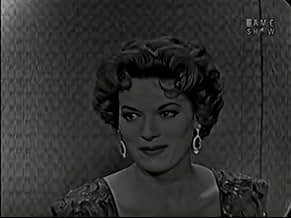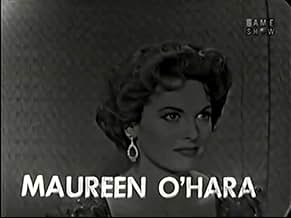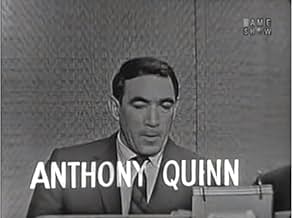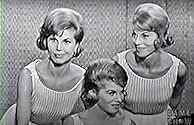What's My Line?
- Série télévisée
- 1950–1967
- 30min
NOTE IMDb
8,5/10
1,9 k
MA NOTE
Ajouter une intrigue dans votre langueFour panelists must determine guests' occupations - and, in the case of famous guests, while blindfolded, their identity - by asking only "yes" or "no" questions.Four panelists must determine guests' occupations - and, in the case of famous guests, while blindfolded, their identity - by asking only "yes" or "no" questions.Four panelists must determine guests' occupations - and, in the case of famous guests, while blindfolded, their identity - by asking only "yes" or "no" questions.
- Récompensé par 3 Primetime Emmys
- 5 victoires et 2 nominations au total
Parcourir les épisodes
Avis à la une
The best "What My Lines" to me are the ones from the 1950's I tape 7 days a week from the Game Show Network.
There is so much history. I have seen many notable people/celebrities from the 50's--Conrad Hilton (Hilton Hotels), Rodgers & Hammerstein, Jo Stafford, Walt Disney, Jane Powell, Lucy & Desi, just to name a few.
Also, as stated here, there's a class and sophistication that is evident from the very beginning of the shows.
Arlene and Dorothy would be introduced and would gracefully appear in the most glamourous/classy dresses and evening gowns.
I loved Bennett Ceif. He was so intelligent and funny. He was publisher and was well versed on so many subjects.
I am taping every one I can because I know in another 10 to 20 years these may never be available again. I also enjoy watching them every evening--it's just as fresh as when they first aired.
There is so much history. I have seen many notable people/celebrities from the 50's--Conrad Hilton (Hilton Hotels), Rodgers & Hammerstein, Jo Stafford, Walt Disney, Jane Powell, Lucy & Desi, just to name a few.
Also, as stated here, there's a class and sophistication that is evident from the very beginning of the shows.
Arlene and Dorothy would be introduced and would gracefully appear in the most glamourous/classy dresses and evening gowns.
I loved Bennett Ceif. He was so intelligent and funny. He was publisher and was well versed on so many subjects.
I am taping every one I can because I know in another 10 to 20 years these may never be available again. I also enjoy watching them every evening--it's just as fresh as when they first aired.
I watched "What's My Line" as a child and am grateful for the chance to see the series again as part of the Game Show Network's current lineup (as of January 2003). This particular show is wonderful in all it's incarnations, though I really enjoy the "early years" from 1951 thru 1967. Besides the fun of guessing the contestants' occupations, it's a joy to listen to the humorous banter of the 4 panelists and the host John Charles Daily. The special guests add an entertaining and historical aspect to the show, as so many of the guests have long since passed away. Though I like many game shows, "What's My Line" will long remain my favorite...and one of the reasons I enjoy the late night hours lately! Check it out before the Game Show Networks revamps their lineup!
Watching reruns of the original What's My Line on the Game Show Network (which has just cancelled its "Black & White Sunday Night," much to my dismay) reminds me of what is missing in today's entertainment: Genuine wit and intelligence. The celebrity participants in this and other "early TV" panel shows simply sparkle in a natural way that is rarely if ever seen in today's world of airbrushed, stage-managed "images." There's an innocence, too, that could never be duplicated 40+ years beyond the heyday of these shows. It's really sad these programs can't find appreciation among a new audience, but perhaps the very qualities that seem so appealing are what hinder that. I hope some day this version of this show gets another chance to captivate audiences the way it captivates me.
I agree with all previous comments about "What's My Line?" (urbane, witty, erudite, sophisticated and intelligent), and I would add this thought: All these appellations are true because this show respected its audience. It did not pander. The panelists were never afraid to use a multisyllabic word. No doubt, some "creative consultant" would stop such behavior today.
Additionally, the show is a time capsule of New York in the '50s. You always knew who was "in town," and often why. Sure, maybe the appearance promoted a Broadway show or a book, but it always seemed more "newsy" than "promotional," unlike today when a talk show host holds up the book or shows an outtake from a movie.
A trivia note: Actress Jayne Meadows appeared as the Mystery Guest on 1 August 1954, the day after her marriage to Steve Allen,who was regular panelist that night. She disguised her voice (as the Mystery Guest often did), prompting Allen to comment that he thought the Mystery Guest might be Minnie Mouse. Panelist Arlene Francis correctly identified Meadows.
Additionally, the show is a time capsule of New York in the '50s. You always knew who was "in town," and often why. Sure, maybe the appearance promoted a Broadway show or a book, but it always seemed more "newsy" than "promotional," unlike today when a talk show host holds up the book or shows an outtake from a movie.
A trivia note: Actress Jayne Meadows appeared as the Mystery Guest on 1 August 1954, the day after her marriage to Steve Allen,who was regular panelist that night. She disguised her voice (as the Mystery Guest often did), prompting Allen to comment that he thought the Mystery Guest might be Minnie Mouse. Panelist Arlene Francis correctly identified Meadows.
I have recently begun watching this show late at night on the Game Show network and I was surprised at how straight it was compared to the more comedic syndicated version hosted by Larry Blyden. John Daly pretty much treated this show as if it were Face the Nation or Meet the Press or other shows of that ilk. However, the big intangible that made this show as great as it was, was the chemistry between the panelists, especially between Arlene Francis, Bennett Cerf and Dorothy Kilgallen. Sure the Allens, Steve and Fred, were also on the panel, but everyone remembers the "big three" of Arlene, Bennett and Dolly Mae. Also, special kudos must go to Phyllis Newman and Aileen "Suzy Knickerbocker" Mehle. Phyllis and Suzy did admirably filling in for Dorothy in the days after her tragic death. Also, Tony Randall and Martin Gabel were great in their roles as the two of them were pretty much permanent guest panelists on the show. This show will always be a perfect example of style, sophistication and downright fun.
Le saviez-vous
- AnecdotesDorothy Kilgallen was the mystery guest on the February 5, 1961 telecast. She had been hospitalized and missed the previous two broadcasts. Newspaper reports of the time revealed nothing about her condition, nor was it discussed on-air. In 1976 her personal chauffeur, Roosevelt Zanders, revealed that he had driven Kilgallen from New York to Washington during a blizzard so she could report on the JFK inaugural festivities for her newspaper. Immediately after the new president was sworn in (January 20, 1961), Zanders drove Kilgallen directly to a New York hospital. Asked by a biographer (in 1976) if his client's condition was alcohol-related, Zanders replied, "I don't say 'drunk.' One of the things that brought it about was having one or two drinks and not eating. Her system ran down that way." On February 5, 1961, with Bennett Cerf on vacation, Arlene Francis went on live TV assuming Kilgallen was still in the hospital only to discover that she was the mystery guest. During an earlier absence from the show in 1958, Kilgallen had reportedly suffered (according to a newspaper wire service) from "exhaustion and anemia." When she missed several shows in 1965, John Daly said on-air that she had injured herself tripping on a rug. She returned to the show with her arm in a sling and then appeared on every telecast for six months, including a live appearance on the night of her death.
- Citations
Steve Allen: Is it bigger than a bread box?
- Crédits fousThe uncredited announcer introduced the first panelist, sometimes the left-most, sometimes the right-most. Beginning with the first panelist, each panelist then introduced the person to his/her left or right, depending upon the first panelist's position. The fourth panelist then introduced moderator John Daly.
- ConnexionsFeatured in Television Land (1971)
- Bandes originalesMelody In Moccasins
(Open Theme 1)
Composed by Wilfred Burns
Original Publisher: Charles Broude, Ltd. (ASCAP)
Original U.S. Publisher: Emil Ascher, Inc. (ASCAP)
Meilleurs choix
Connectez-vous pour évaluer et suivre la liste de favoris afin de recevoir des recommandations personnalisées
- How many seasons does What's My Line? have?Alimenté par Alexa
Détails
- Date de sortie
- Pays d’origine
- Langue
- Aussi connu sous le nom de
- Occupation Unknown
- Lieux de tournage
- Sociétés de production
- Voir plus de crédits d'entreprise sur IMDbPro
- Durée30 minutes
- Mixage
- Rapport de forme
- 1.33 : 1
Contribuer à cette page
Suggérer une modification ou ajouter du contenu manquant

Lacune principale
By what name was What's My Line? (1950) officially released in India in English?
Répondre































